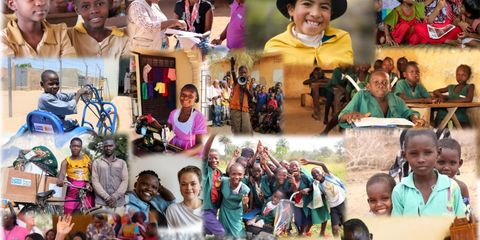Child marriage in Bangladesh
Bangladesh has one of the highest rates of child marriage in the world. Around two thirds of women aged 20 to 24 marry before the age of 18, despite the minimum legal age being 18 for females.
To help strengthen work on preventing child marriage, Plan International Bangladesh commissioned a national-level study on child marriage. The objective was to understand the present situation of child marriage in the country and identify causes of, and factors associated with, child marriage. Findings from the study are referred to in this report.
Preventing child marriage
Among the issues examined in this report are:
- The causes of child marriage in Bangladesh
- Awareness about child marriage and its consequences
- Awareness about laws against child marriage
- The prevention of child marriage
- Effectiveness of Plan International’s interventions.
Status of child marriage in Bangladesh
According to a UNICEF report released in 2011, one-third of women aged 20 to 24 in Bangladesh were married by the age of 15, and about two-thirds were married by the age of 18.
A recent study by the International Centre for Diarrhoeal Disease Research in Bangladesh shows an improving trend, with 64% of women aged 20 to 24 married before 18 years of age.
According to this study, a higher proportion of women (71%) in rural areas are married before 18, compared to 54% of women in urban areas. The study also shows a strong association between child marriage and education and economic status, with higher rates of child marriage among women with low or no education and for those from families living in poverty.
Among women aged 20 to 24, there has been a negligible increase in the median age at marriage, from 16 years in 2004 to 16.4 in 2007 and 16.6 in 2011.
The decline in the incidence of child marriages has been slow. Among women who are currently aged 45 to 49, 77% were married by the time they were 18. The corresponding figure for women aged 20 to 24 is 70%. The change is more significant with regard to marriages below 15. 43% of women aged 45 to 49 were married by age 15; the corresponding figure for women aged 15 to 19 is 23%.
Legal protection
Under the Child Marriage Restraint Act (1929), the legal age of marriage in Bangladesh is 18 years for a female and 21 years for a male. Penalties for child marriage according to the Act are imprisonment for one month or a fine of up to 1,000 taka (€9.4) or both. Any adult or guardian arranging and permitting child marriage can be convicted under the law. Girls cannot be sentenced to imprisonment.
To be pursued, a case has to be registered with a court of law within 1 year of the marriage. If an impending child marriage is brought to a court’s notice, it can be legally prohibited. However, once completed, a child’s marriage is not considered invalid (Emory Law School no date). In 2004, the Birth and Death Registration Act was amended and makes it essential for a bride and groom each to have a birth certificate before a marriage can be registered.
Bangladesh is a signatory to the UN Convention on Consent to Marriage, Minimum Age for Marriage and Registration of Marriages. This Convention requires signatory states to obtain consent from both parties entering into a marriage and to establish a legal minimum age for marriage.
Plan International programmes in Bangladesh
Plan International has been operating in Bangladesh since 1994 and works in 4 districts across the country – Dinajpur, Gazipur, Lalmonirhat and Nilphamari – and in Dhaka city.
Plan International Bangladesh has developed a multi-pronged community development programme using a rights-based, community-centred child development (CCCD) approach. The programme includes advocacy initiatives at national and local levels, awareness-raising activities about child marriage and other developmental issues among various stakeholders, and the promotion of community-based organisations of children and adults.
Plan International Bangladesh also provides training on life skills, health and sanitation, and vocational skills to children.
In 1998, Plan International Bangladesh conducted a situation analysis as a part of its CCCD approach. Two core findings at that time were a high prevalence of child marriage and dowry payments. Since 2005, a core area of work for Plan International Bangladesh has been ending child marriage.
Country strategic plan
In its Country Strategic Plan 2010-2015, Plan International Bangladesh lists reduction of child marriage in rural areas as one of its programme objectives. At the programme unit level, the objective is to increase the mean age of girls at marriage from 15 to 18 in Plan International’s working areas by 2015, and to strengthen government mechanisms by supporting its online birth registration system and enforcement of the Child Marriage Restraint Act.
This will be achieved through awareness-raising activities among stakeholders, life-skill training for adolescents, promotion of peer leaders and advocacy efforts with duty bearers. Child marriage is also addressed through Plan’s community-managed health care programme, which includes a focus on adolescent girls.
The indicators for measuring outcomes are: mean age of marriage; the number of districts that have established online birth registration information systems; and the number of police stations that have established a system for reporting child marriages. Plan International is also part of an advocacy effort aimed at incorporating the issue of child marriage into the national text books for secondary education.
To provide inputs for strengthening its work on child marriage, Plan International Bangladesh commissioned a national-level study on child marriage. (The objective of the study was to understand the present situation of child marriage in the country and identify causes of, and factors associated with, child marriage). Findings from this study are referred to in this report.
Objectives and research questions
The study sought to explore the perceptions of different stakeholders regarding the causes and consequences of child marriage and the efficacy of Plan International’s programming in addressing these factors.
It also sought to understand the issue from the perspective of children who were exposed to Plan International’s programmes and to compare their responses to those who were not.
The main research question the study sought to answer was, “How effectively have Plan International’s child-centred approaches in Bangladesh, India and Nepal addressed the causes and consequences of child marriage?” To answer this question, the research examined how Plan International’s interventions in each of the 3 countries worked at the individual, family and community levels.
Child marriage interventions
More specifically, the study sought to answer a series of sub-questions relating to the main research question. These were:
Have Plan International’s interventions in Bangladesh:
- Increased awareness regarding child marriage laws and the consequences of child marriage among individuals, families and the community?
- Increased negotiation skills among children and empowered them to prevent child marriage?
- Succeeded in increased awareness and action by local and national state institutions to prevent child marriage?
- Succeeded in creating enabling environments for the reduction of child marriage as a result of its partnership with the state and advocacy efforts?
- Successfully transitioned from a service delivery to a rights-based approach?
The study also sought to understand what can be learnt from specific cases of child marriage prevention and examples of best practice within Plan International’s programming and advocacy efforts.
Download options
report
1.81 mb
Categories: Campaigns, Protection from violence


